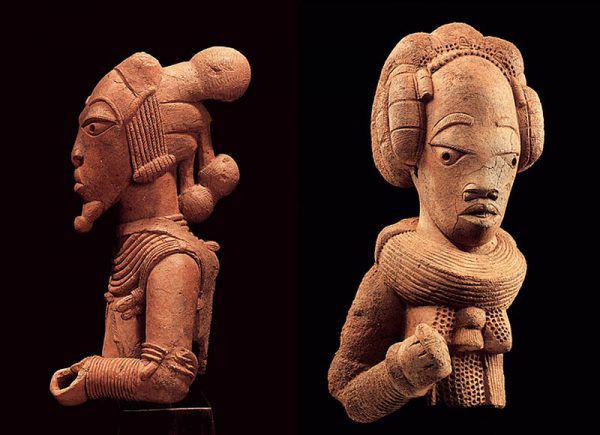The Nok culture is said to have belonged to a homogenous group of people who had a well ordered economy and a good system of government.[1]According to Archaeological discoveries, The Nok civilization-around (500BC-200AD)-is one of the earliest known civilizations. This means that as far back as 9000 BC, There was a history of human existence in Nigeria.[2] The Nok culture, which is also called the Nok Figurine culture, is an ancient Iron-age culture that existed on the Benue Plateau of Nigeria.
Discoveries at the Nok Sites

- The artifacts of the Nok culture are named after the Ham village of Nok in Kaduna state of Nigeria, where the famous terracotta sculptures were first discovered in 1928.[3] This allusion is that, the Nok people were ancestors of the Ham people. This is made based on the fact that, there was a similarity in the economic practices and manner of appearance. For example, the Ham people wear a lip plug and an ear plug, something that was discovered as a similarity with the ancient Nok people.
- The first NokTerracota was discovered by Dent Young in 1928. Dent was a co-owner of a mining partnership near the Nok village in the Jos Plateau. The discovery of the terracotta was actually an accidental incident. It was unearthed at a level of 24feet from an alluvial tin mine.[4]
- The Nok sites contains remain of burnt plant remains; including firewood and plant materials for cooking. Also, Pearl millet, which is one of Africa’s oldest grain crops was found on those sites. Cowpea was also found on the site.
- The seeds of some wild fruits, grasses and legumes were also discovered.[5]
- The only evidence for animals during the Nok culture was depicted by the figurines or terracotta sculptures. Possibly, there was no preservation of animal bones in the Nok culture, because of the acidic nature of the soils.
- The Nok Terracotta figures and Terrawita heads are amongst the oldest works of art ever known in Nigeria.[6]
- Terra-cotta refers to a technical work which implies to ‘baked clay’.
- The three main sites of excavation of the Nok artifacts are the Nok, Katsina-Ala and Taruga. A lot of materials have been discovered by archaeologists.
- Some sources state that most of the Nok Terracotta figures are male; this identification is possible because of the kinds of body decorations, moustache, beards, attires hairdos etc.
- The Nok People are regarded as the first Iron workers in the Sub-Saharan Africa. The used their iron implements to enhance their agronomic practices. They were also hugely engaged in hunting.
- Most of the Nok sculptures are depicted by human beings, animals, plants. Most of the terracotta figures are represented by different postures such as sitting, genuflecting (kneeling) and standing.
Sources: Vanguard, Answers Africa,
Peter Breunig, Nok:African Sculpture in Archaeological Context. (Frankfurt: Africa Magna, 2014,) 21.
Chesi, G. and Merzeder, G. The Nok Culture: Art in Nigeria 2500 Years Ago. 2006
Breunig, Archaeological Context, 15.
Featured Image Source: Live Journal


